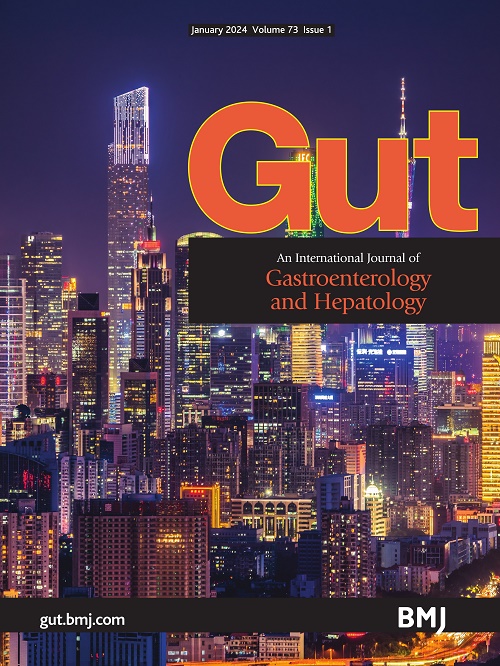体外微生物群模型概括和预测个体化对膳食乳化剂的敏感性
IF 23
1区 医学
Q1 GASTROENTEROLOGY & HEPATOLOGY
引用次数: 0
摘要
包括羧甲基纤维素(CMC)在内的非吸收性膳食乳化剂会直接扰乱肠道微生物群,从而促进小鼠的慢性肠道炎症。一项随机对照喂养研究(人类乳化剂的功能研究,FRESH)发现,CMC也会对一些(但不是全部)健康个体的肠道微生物群产生不利影响。目的本研究旨在建立一种方法,通过他们的基线微生物群来预测个人对饮食乳化剂的敏感性。我们评估了体外微生物群模型(MiniBioReactor array, MBRA)再现和预测个体供体对乳化剂敏感性的能力。分析宏基因组以确定乳化剂敏感性的特征。结果维持在MBRA中的人类微生物群暴露于CMC,再现了FRESH受试者先前观察到的CMC敏感性差异。此外,在MBRA模型中,选择FRESH对照对象(即不喂食CMC)的微生物群受到CMC暴露的高度干扰。cmc诱导的微生物群扰动与基线宏基因组特征相关,表明使用宏基因组预测饮食乳化剂敏感性的可能性。将MBRA模型认为对CMC敏感而非不敏感的人类微生物移植到无IL-10−/−细菌的小鼠中,在喂食CMC后会导致明显的结肠炎。结论:这些结果表明,个体对乳化剂的敏感性是检查其基线微生物群的结果,因此可以通过检查其基线微生物群来预测,从而为基于微生物群的个性化营养铺平道路。所有与研究相关的数据都包含在文章中或作为补充信息上传。本文章由计算机程序翻译,如有差异,请以英文原文为准。
In vitro microbiota model recapitulates and predicts individualised sensitivity to dietary emulsifier
Background Non-absorbed dietary emulsifiers, including carboxymethylcellulose (CMC), directly disturb intestinal microbiota, thereby promoting chronic intestinal inflammation in mice. A randomised controlled-feeding study (Functional Research on Emulsifiers in Humans, FRESH) found that CMC also detrimentally impacts intestinal microbiota in some, but not all, healthy individuals. Objectives This study aimed to establish an approach for predicting an individual’s sensitivity to dietary emulsifiers via their baseline microbiota. Design We evaluated the ability of an in vitro microbiota model (MiniBioReactor Arrray, MBRA) to reproduce and predict an individual donor’s sensitivity to emulsifiers. Metagenomes were analysed to identify signatures of emulsifier sensitivity. Results Exposure of human microbiotas, maintained in the MBRA, to CMC recapitulated the differential CMC sensitivity previously observed in FRESH subjects. Furthermore, select FRESH control subjects (ie, not fed CMC) had microbiotas that were highly perturbed by CMC exposure in the MBRA model. CMC-induced microbiota perturbability was associated with a baseline metagenomic signature, suggesting the possibility of using one’s metagenome to predict sensitivity to dietary emulsifiers. Transplant of human microbiotas that the MBRA model deemed CMC-sensitive, but not those deemed insensitive, into IL-10−/− germfree mice resulted in overt colitis following CMC feeding. Conclusion These results suggest that an individual’s sensitivity to emulsifier is a consequence of, and can thus be predicted by, examining their baseline microbiota, paving the way to microbiota-based personalised nutrition. All data relevant to the study are included in the article or uploaded as supplementary information.
求助全文
通过发布文献求助,成功后即可免费获取论文全文。
去求助
来源期刊

Gut
医学-胃肠肝病学
CiteScore
45.70
自引率
2.40%
发文量
284
审稿时长
1.5 months
期刊介绍:
Gut is a renowned international journal specializing in gastroenterology and hepatology, known for its high-quality clinical research covering the alimentary tract, liver, biliary tree, and pancreas. It offers authoritative and current coverage across all aspects of gastroenterology and hepatology, featuring articles on emerging disease mechanisms and innovative diagnostic and therapeutic approaches authored by leading experts.
As the flagship journal of BMJ's gastroenterology portfolio, Gut is accompanied by two companion journals: Frontline Gastroenterology, focusing on education and practice-oriented papers, and BMJ Open Gastroenterology for open access original research.
 求助内容:
求助内容: 应助结果提醒方式:
应助结果提醒方式:


